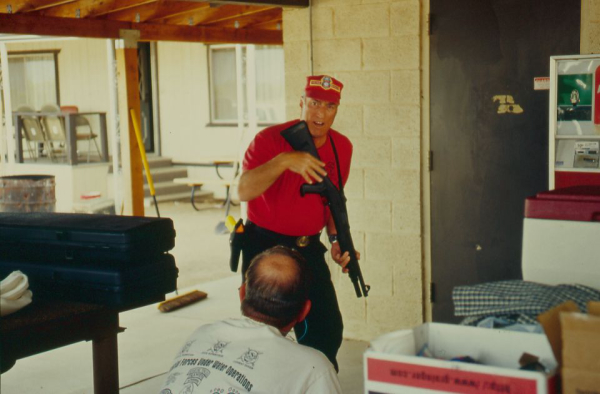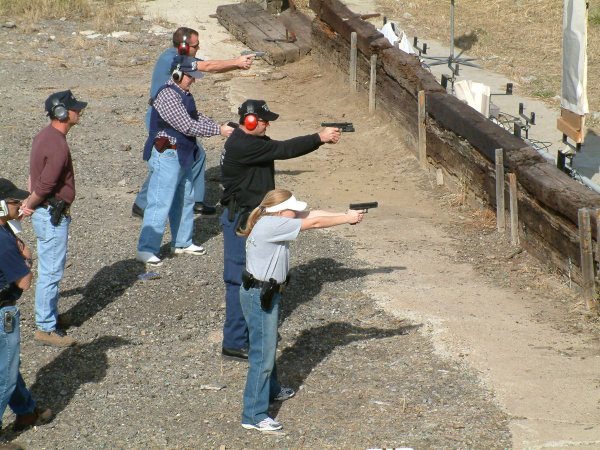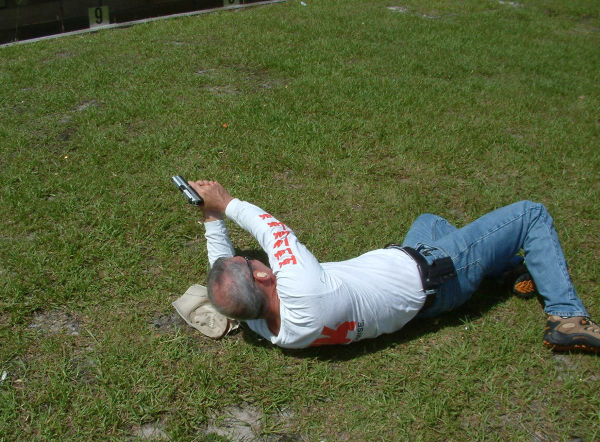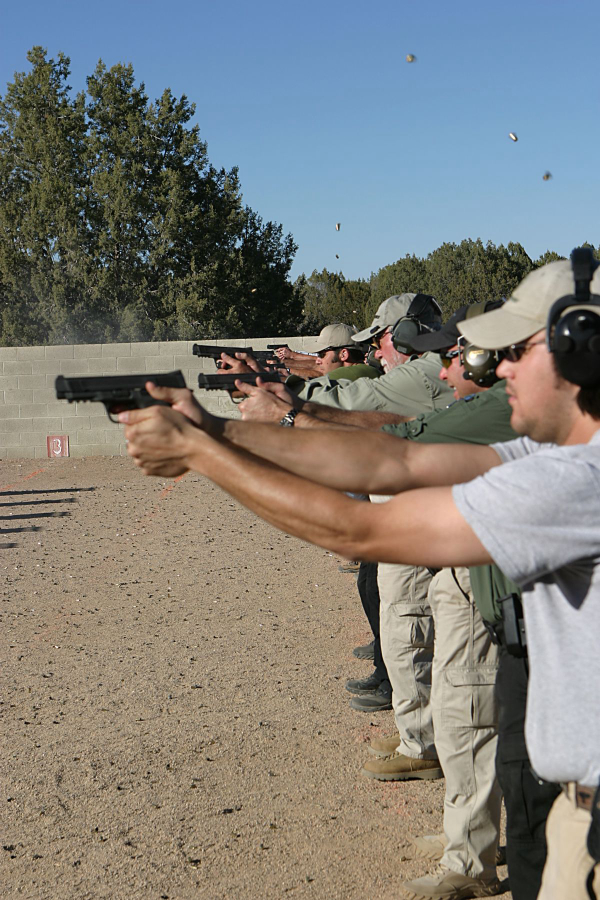Today’s feature is from correspondent Dave Spaulding.

From Mr. Webster…
Mode: noun
1. a manner of acting or doing; method; way: “Modern modes of transportation.”
2. a particular type or form of something: “Heat is a mode of motion.”
3. a designated condition or status, as for performing a task or responding to a problem: “A machine in the automatic mode.”
I have been teaching firearms for 40 years now. I entered the training arena as trainer for my agency’s newly formed SWAT team. Like many teams of the era, there was not a lot of background information to draw on, so we used Army field manuals, a basic course taught by the state training academy and a lot of phone calls across the nation to get started. Command officers knew we needed a “certified” firearms instructor for the team and since I was the youngest member…and likely to stay the longest…I was “volunteered” to go. I liked guns, so I didn’t mind the five- week journey (a week each for revolver, pistol, shotgun, rifle/submachine gun and instructional skills) to “instructor-hood” and as it turned out, I liked instructing. I started helping out the regular range officer and as time went by, I moved away from SWAT over to more conventional law enforcement firearms instruction, which meant more focus on the handgun.
After all, the handgun always has been and always will be the primary firearm for American law enforcement. The same can be said for the armed citizen. While the carbine and shotgun are certainly more effective, the handgun is more portable and concealable, meaning it will be the gun available when an unexpected incident unfolds. The handgun is a reactive/reflexive style of firearm while the long gun is more responsive…the handgun will be available most of the time while the long gun will be the gun used when one has time and knows what they are responding to such as the military application of a small arm…or SWAT for that matter.

As I have gone through this multi-decades long journey of instruction, mostly focusing on the handgun, I have noticed that four “modes” of combative pistolcraft training exist and they are a result, mostly, of the background a given instructor comes from. I spent most of my adult life in law enforcement and when I started to focus on the training of armed citizens, this background “colored” how I taught the subject matter. I now realize I was partly wrong in doing so. Oh, I didn’t endanger anyone, but I could have had a more task specific focus.
I began to think about the various modes due to a pistol course I took from a retired Special Operations member. As a former member of a high-speed, direct-action unit, his standards were quite high and I was interested in seeing what he taught and why he taught it. Much to my disappointment, he never really said…it was mostly “do what I say”. We spent a sizable amount of time shooting beyond 25 yards…50, 75 even out to 100 yards with semi-automatic pistols. While this is certainly doable, I could not help but question why we were spending such a large amount of time on something that was unlikely, even ill -advised legally.
At first, I thought it was for marksmanship, but when I asked him, I was told, “how long is the front hallway of a Wal-Mart, Home Depot, Lowes? What if you have to make a shot to save your family at such a distance?” I don’t know about this, folks. The legality of such an action…especially if it were to go astray…filled my head but I decided not to challenge. After all, it was his class and he certainly has the right to teach as he chooses. I left the class thinking deeply about what I had just experienced. After all, when I entered law enforcement in the mid-1970’s, long distance revolver shooting was emphasized but was stopped after research into armed conflict involving cops showed it seldom happened. Emphasis was placed on just the opposite…extreme close quarter engagements.
After a bit of reflection, it struck me that every instructor will teach what they know, have experienced and been taught based on their background and one is no more or less relevant than the other…it’s just a matter, as a student, if that particular mode fits YOUR real world of work…and only you can decide that. Let’s look at these varied modes:
1. Military: The military does everything they can to KILL THE ENEMY (an important distinction) at GREAT distance. It is the way it should be. If they can kill the enemy (no intelligence value, of course) in Iraq from a trailer in Nevada using a drone, then they should. Distance favors the trained shooter, so the further away one can be from an adversary when the fight breaks out, the greater advantage we (those trained) have in winning the fight. Shooting at contact distance requires no skill, just tenacity, so trying to engage far away increases survivability.
The problem arises in the fact the pistol is not designed for such long shots. With a short barrel and reduced sight radius long shots become problematic. Yes, with practice they can be made but how many folks who carry a handgun for personal security purposes possess this level of skill? It’s one thing to make a 100 -yard shot on the square range with little stress, but quite another while under the duress of a real gunfight with non-hostiles running through the battle space in panic, which would be the case in a large box store.

2. Law Enforcement: Unlike the military, law enforcement does not kill the enemy; they police society and thus, TAKE PEOPLE INTO CUSTODY (another important distinction). Great strides are taken to arrest offenders and take them in front of a judge. Even in extreme situations like hostage rescues, the goal is to apprehend the offender, not kill. Offensive action, like a sniper shot, is avoided if at all possible and is only used as the final option.
Because of this arrest standard, law enforcement will always be an activity of close contact. Even in situations that do not involve arrest such as citizen contacts, those involved wish to keep the interaction as private as possible, thus close contact is required. Can you imagine the uproar if a patrol officer stood back 10 yards and yelled to an honest citizen, “HEY! THROW ME YOUR IDENTIFICATION! I DO NOT WANT TO GET TOO CLOSE UNTIL I FIND OUT WHO YOU ARE!” Nope…that will not go over well with the citizenry.
Law enforcement has known for over a century that the single most dangerous moment is when the first handcuff goes on. That is likely when a fight will start. I have been there numerous times and it is not an enjoyable experience. Four times during my career I fought over my own gun in such situations and all were quite perilous. None ended in death because in those days, we were allowed to HIT PEOPLE HARD, something that is judged as cruel, mean and heartless in the days of the cell phone video. A punch to the throat or poke to the eyes always ended such attacks. That said, with close contact being a reality, is it any wonder why law enforcement shootings tend to be within double arms-length to ten feet?
3. The Armed Citizen: A distance of six yards seems to be a continuing aspect of armed citizen confrontations. I have seen this distance so many times now, that I have started to incorporate it in my training courses. It makes sense as armed citizens ARE NOT DUTY BOUND TO APPREHEND, ARREST AND CERTAINLY DO NOT WISH TO KILL…THEY WANT TO REPEL AN ATTACK AND GET THE ATTACKER TO STOP (another important distinction). If the attacker flees, that’s just fine.
For this reason, armed citizens create distance between themselves and the potential threat, distances like the length of a car, across a parking space, a living room or a public hall way…a distance in which they can converse, issue warnings but also retain a reactionary gap. Just a few steps can increase distance/awareness significantly. In many cases, their hand is on or near their holstered sidearm, but it has not yet been displayed. For whatever reason, the individual could not avoid the situation so they are now trying to evade by creating distance and allowing the potential attacker to move on. This is a wise move! Engaging in a deadly force situation is life changing and costly. The armed citizen is not duty bound so they should avoid or evade at all costs. Breaking contact even after the fight has started is still a correct choice.

4. Felons: Their mode of thought is quite simple…THEY WISH TO COMPLETE WHATEVER CRIMINAL ACTION THEY HAVE STARTED AND GET AWAY. In some cases, it is violence committed in the act of another crime (robbery, theft, etc.) In others it is the act of violence itself that satisfies the offender. In any case, they wish to flee the scene once the act is completed. It should be understood that they do not see the world as you do, they do not think like you do and they were not raised as you were. DO NOT APPLY HOW YOU THINK ABOUT A PARTICULAR SITUATION TO THEM!
They are not “trained” in combative pistolcraft per se and do not concern themselves with “legalities,” after all, they are already committing multiple crimes. Thus, if gun play is involved, they will not worry about shot placement, who is hit, where their bullets go and will likely spray the area with bullets in order to assist their escape. While they may not be traditionally trained, many have been involved in gunfights...some have been shot…thus they will have NO APPREHENSION about shooting at you, your loved ones or anyone in the area. Fortunately, many choose to flee instead of shoot, but one cannot count on this…some offenders just like violence.
You will be worried about such things as legalities and misplaced shots. Your mind might be filled with them as you deploy your handgun. They will not! Crime is their occupation, violence just a way of life.
As I wrap up this already too long article, I want to go back to the definitions listed at the beginning. A mode is “A manner of acting or doing; method; way” and this method or way will certainly be affected by one’s background. In addition, when it comes to training, many instructors have been trained to operate in certain environments…I know I was! It makes sense, why would a war fighter train himself or herself to function as an armed citizen? It’s not their “real world of work”.
As we proceed through this “journey of discovery” that is training and preparation, we must all decide what our real world of work and play is and proceed accordingly. Does that mean we cannot “dabble” in military style training? Of course not, I believe we should seek training from a wide variety of sources. But when it comes to building skills, mastering and anchoring them to a level of “automaticity” (a longer process than many understand), we need to use critical thought and choose wisely…not be sucked into the world of tacti-cool and fantasy. The reality of conflict is awful…you don’t want to make it worse by preparing incorrectly…
Dave Spaulding is a professional firearms instructor with 36 years' experience in Law Enforcement and Federal Security. The recipient of the 2010 Law Enforcement Trainer of the Year Award from the International Law Enforcement Training and Educators Association (ILEETA), Dave has worked in all facets of law enforcement including communications, corrections, court security, patrol, evidence collection, training and investigations. He was a founding member of his agency’s SWAT Team and acted as its training officer for 8 years. He spent a year in an undercover capacity and was the commander of a multi-jurisdictional narcotics task force, has been an adjunct instructor at the former Heckler & Koch International Training Division and the Tactical Defense Institute. In addition to his many published articles (over 1,400), Dave is the author of two acclaimed books, Defensive Living and Handgun Combatives. He operated his own training company with focus on “the combative application of the handgun” www.handguncombatives.com .